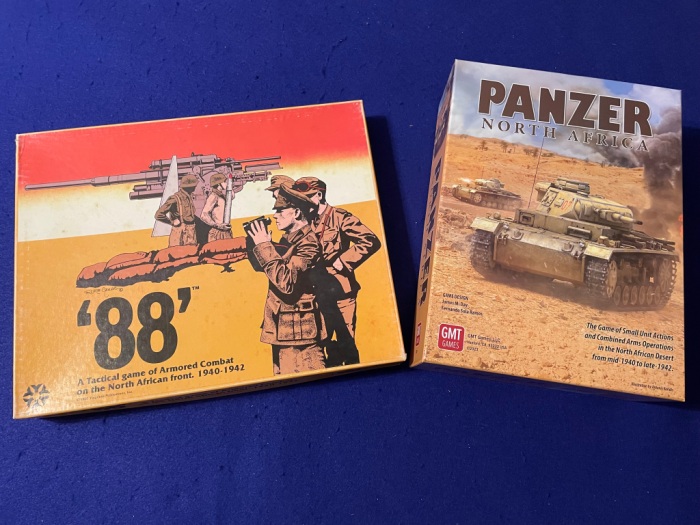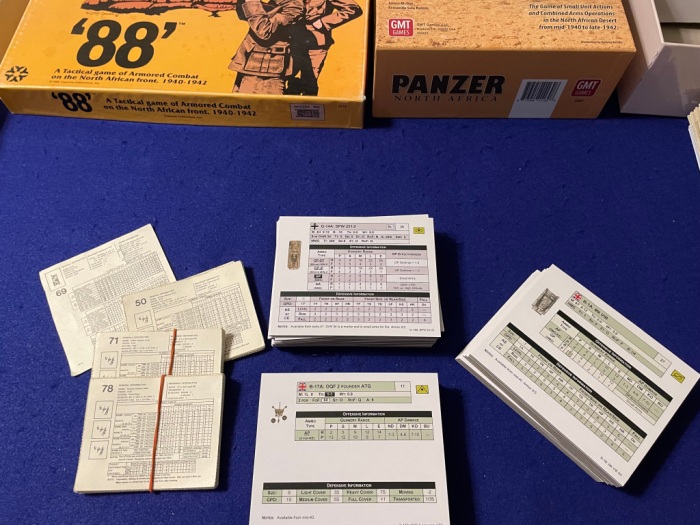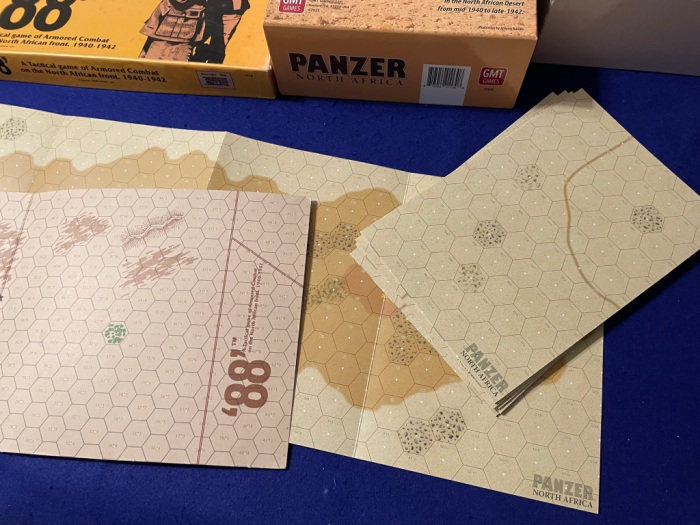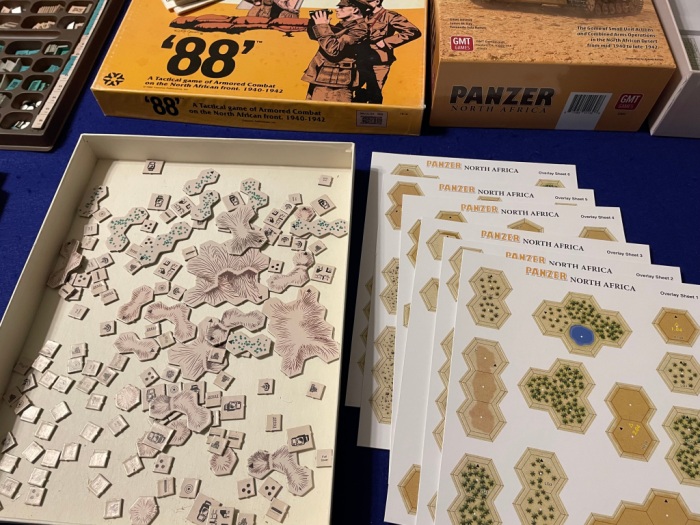RockyMountainNavy, 15 February 2024 ~ #UnboxingDay
A recently published war game to enter my battle space is Panzer North Africa by Jim Day with Fernando Sola Ramos for GMT Games (2022/3/4 depending on what you look at). Panzer North Africa is the latest entry in the GMT Games edition of the Panzer series which traces it lineage back to the first edition of Panzer: A Tactical Game of Armored Warfare on the Eastern Front, 1941-1945 designed by Day and published by Yaquinto Publications, Inc. in 1979. The second game in that original series was ’88’: A Tactical game of Armored Combat on the North African front, 1940-1942 by Day for Yaquinto in 1980. Comparing ‘88′ and Panzer North Africa, published 44 years apart, shows how much the wargaming hobby has changed as well as how much traditional war game goodness remains.
Title fight
Panzer North Africa is the sixth game in the GMT Games Panzer series. It is also the second complete game in the series with the four previous all being expansions. The core game – expansion production approach of GMT Games is far different than the approach Yaquinto used which was to make every game in the series a stand-alone product. Personally, I am very pleased to see Panzer North Africa get “the full treatment” because of the original Panzer series (Panzer – ’88’ - Armor) it was ’88’ that I played the most play back in the day. I kind of wish GMT Games kept the ’88’ name but I understand, as a grognard, that kind of a specific historical reference is likely lost on a different generation of wargamers historical conflict simulation players that already are put off by a game with hexes and counters and a combat resolution mechanism that requires table look-ups, much less a reference to a German artillery piece with a mythos built up around it.
Boxing match
My first introduction to the artwork of esteemed Rodger B. MacGowan was the cover of Yaquinto Panzer in 1979. MacGowan also did the cover of ’88’ (and later Armor) and many, many more games I own. When GMT Games picked up the Panzer series it was MacGowan who did the cover for the core game and each of the four expansions. So tied is MacGowan to Panzer in my mind that it is frankly shocking to see Panzer North Africa not adorned with MacGowan art. That said, I am actually very pleased with the cover art of Panzer North Africa from Antonis Karidis which is excellent and goes a long way towards making Panzer North Africa distinct from ’88’.
The box of Panzer North Africa also shows the evolution of war games in the past 44 years. In the early days of wargaming many boxes were flat as the industry drew much packaging inspiration from hobby boardgames. It was Avalon Hill and games like Squad Leader that fully embraced the bookcase format, the legacy of which is seen in many GMT Games today like Panzer North Africa.
[As as bit of an aside, it was Yaquinto in the late 1970’s and early 1980’s that experimented with Album Games which were packed in double-LP album covers. Like many magazine games of today it was always a question of how to store the counters.]
There are some historical conflict simulation haters out there that will denigrate Panzer North Africa as too heavy a game. While I will gladly argue with them all day about how easy the GMT Games Panzer series is to play once a few rules are understood, I cannot argue the fact that Panzer North Africa is a heavy game to ship—a no-kidding 8 pounds of heaviness. This heaviness means GMT Games uses a 3.5″ deep box for Panzer North Africa that is packed to the gills with components. It is a far cry from the 2.5 pounds of ’88’ which was a pretty standard boardgame in it’s day.
A page of history
Part of the reason Panzer North Africa is so heavy to ship is the amount of printed material included. The original ’88’ came with a single 40-page rulebook in a unique Yaquinto 8.5″ x 11″ landscape format that contained all the rules, scenarios (four plus “Doing Your Own Scenarios”) and historical background. Panzer North Africa, by contrast, ships with six stapled books:
- Basic & Advanced Rules – 68 pages
- Optional Rules – 24 pages
- Scenario Book I – 68 pages (11 scenarios plus 4-scenario campaign game)
- Scenario Book II – 64 pages (17 scenarios)
- Playbook – 32 pages
- TO&E [Table of Organization & Equipment] Manual – 20 pages
The exponential growth in rules and other printed material is a testimony to the power (and patience?) of the fans of the GMT Games Panzer series. It also is a case study in the response of some war game publishers to demands from fans for more materials which includes illustrated, color rules, more explanatory rules, many more scenarios, an extended example of play in a playbook, and more historical material to help players develop their own scenarios. Don’t forget that the GMT Games Panzer series also enjoys a robust fan base with web presence in the form of sites like The Panzer Pusher run by co-designer Fernando Solas Ramos.
CRT
The player aids in Panzer North Africa also show the evolution of war games in the past 44 years. Yaquinto’s ’88’ shipped with a pad of Command Sheets for plotting orders (oh, the horror!), two player aid cards with tables, and two target angle wheels (“wheels of death”) used to determine the angle of incoming fire. Panzer North Africa doesn’t use plotted commands but still has play aids with charts and tables but in full color. Premium production for a premium game.
Play your cards
A unique component of the Panzer series, from ’88’ to Panzer North Africa, is the use of cards to show the values of combat units. The cards in ’88’ were printed on slightly heavier cardstock with perforated edges for separating each one that measured about 3″ x 4″ with very fine print. Panzer North Africa still used cards, but each is a larger roughly 4″ x 5″ card that still has small print but not as small as ’88’.
Unlike ’88’ which actually has data for vehicles on both sides of a card, Panzer North Africa presents all the data necessary for play on a single side of a card. The Panzer North Africa cards are also helpfully in color.
Endless desert
On war game component that is little-changed over the 44 years between ’88’ and Panzer North Africa is the use of folded paper geomorphic map boards. Yaquinto’s ’88’ shipped with six single-sided 21″ x 9″ geomorphic map boards with 3/4″ hexes. Panzer North Africa also uses geomorphic map boards but ships six double-sided 27″ x 10″ map boards using 1″ hexes.
Desert features
One feature of the old Yaquinto Panzer-’88’-Armor series I really enjoyed was the placement of terrain cutouts directly on the map boards. The very-miniatures wargame like feature meant that features on the map—literally—stood out. Panzer North Africa also uses cutout terrain overlays, but the card stock is much thinner than that used in ’88’ and, though in full color, has less literal “pop” off the board.

Motor pool
The eight countersheets in Panzer North Africa account for a majority of the 8 pounds shipping weight. That should be expected given Panzer North Africa has 352 7/8″ counters and a further 704 5/8″ counters. I don’t have an exact count, but I estimate ’88’ came with maybe a bit over 400 counters that have silhouettes only and no game data like the newer Panzer North Africa counters do.
Game over
I admit that it is a bit unfair to compare ’88’ to Panzer North Africa. When Yaquinto printed ’88’ it was representative of the general (average?) quality of war game production at the time. Panzer North Africa, on the other hand, is certainly representative of the higher-end of the publishing used by today’s hobby wargame industry. The difference is no more clearly seen than in the quantity and quality of the components between ’88’ and Panzer North Africa. What is not different is my expectation from both games. Long ago I played the h3!! out of ’88’ and I look forward to getting Panzer North Africa to my gaming table many times in the coming year.
Thank you for visiting The Armchair Dragoons and mounting up with the Regiment of Strategy Gaming.
You can find our regiment’s social media on Mastodon, BlueSky, Facebook, TwXtter, YouTube, and even Threads, if we could ever get an auto-post to it.
(We have an Instagram page and it’s really just a placeholder & redirect to our articles.)
You can support The Armchair Dragoons through our Patreon, also, and find us at a variety of conventions and other events.
Feel free to talk back to us either in our discussion forum, or in the comments below.
In wargaming discussions, they shine,
Armchair Dragoons, so refined,
With tactics profound,
Strategies unbound,
Their insights, a treasure divine!







